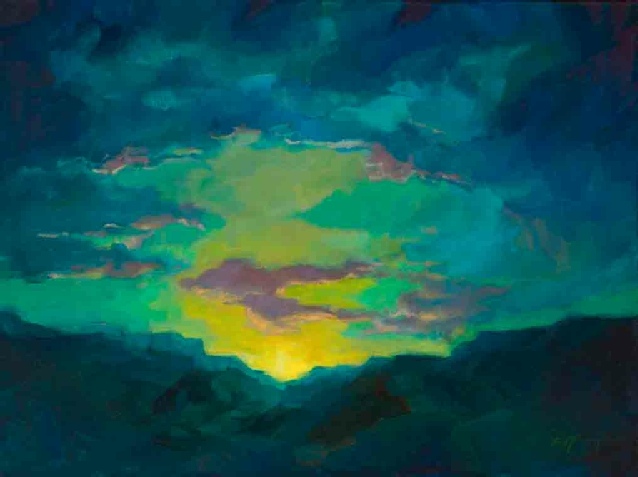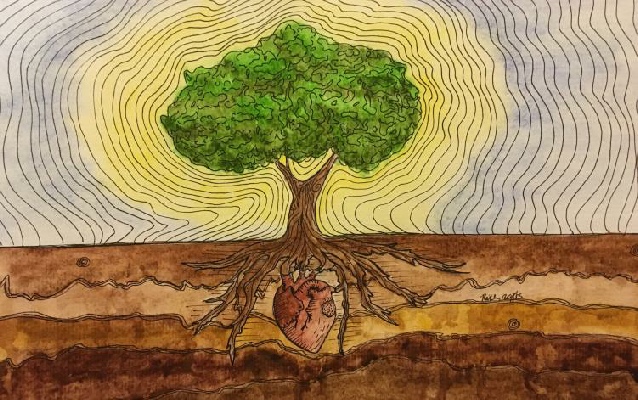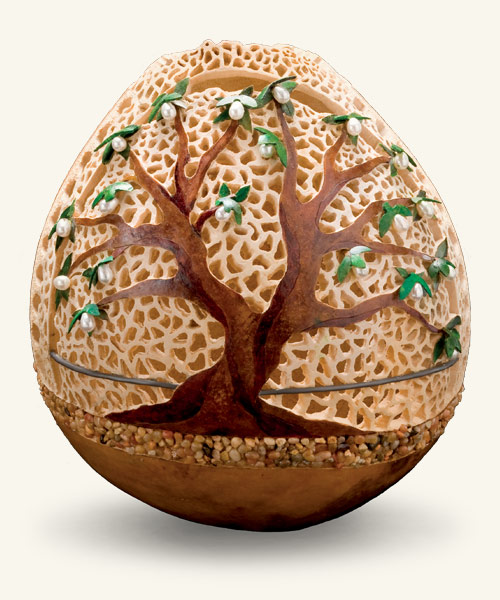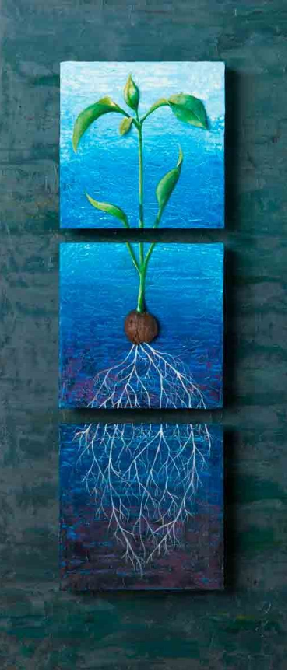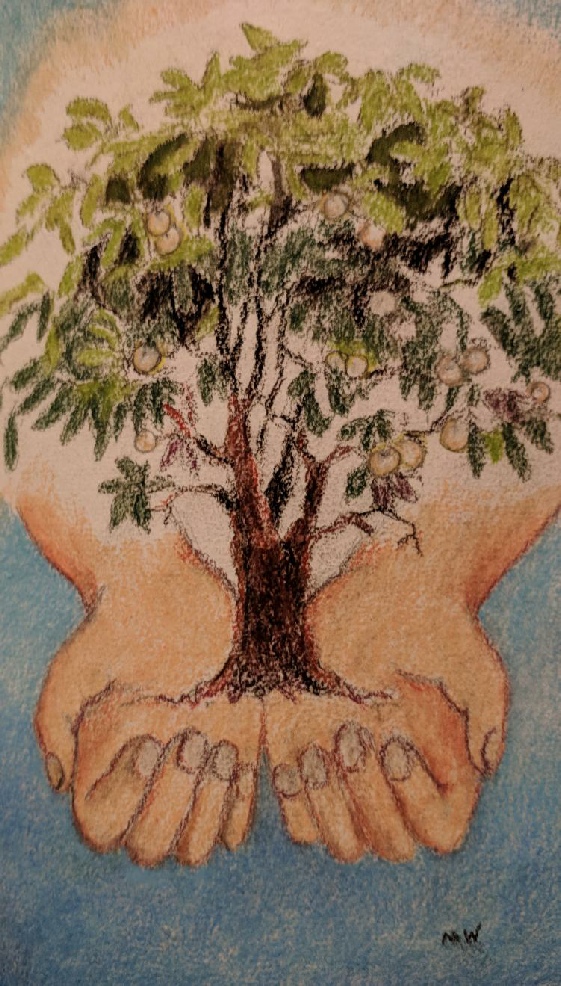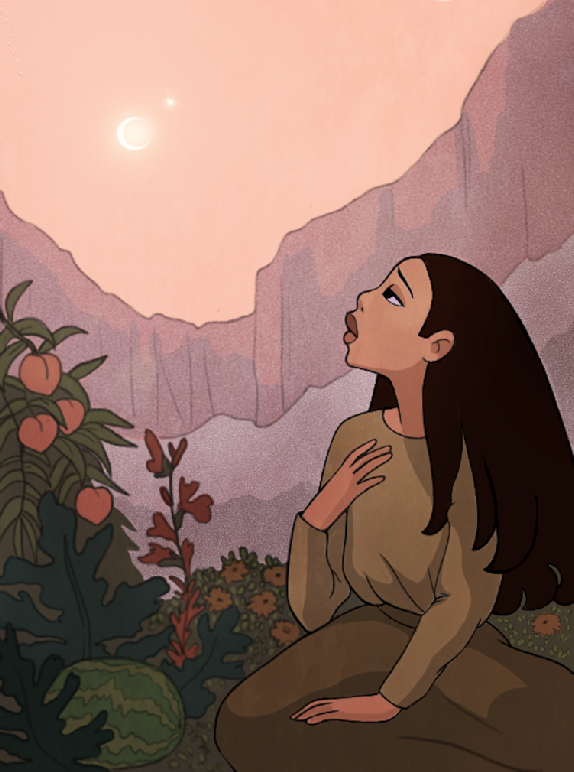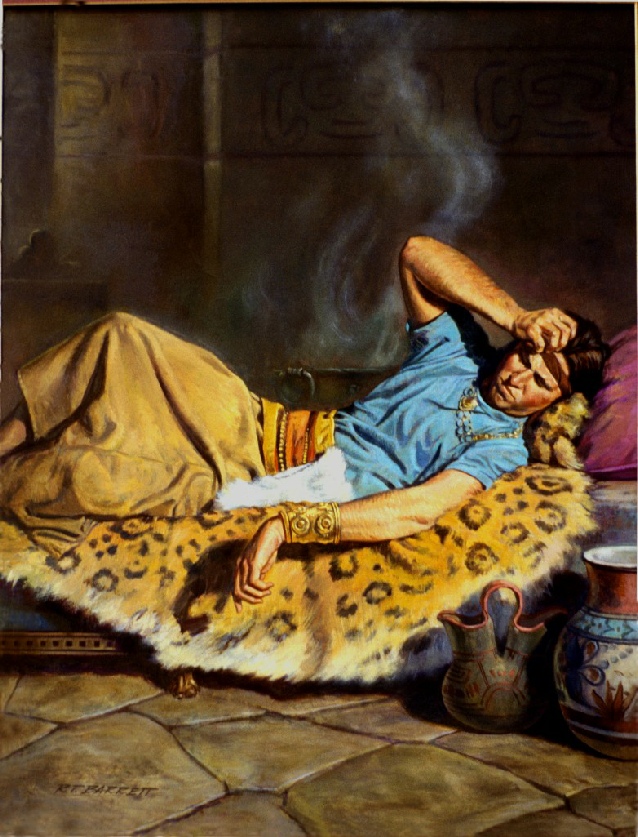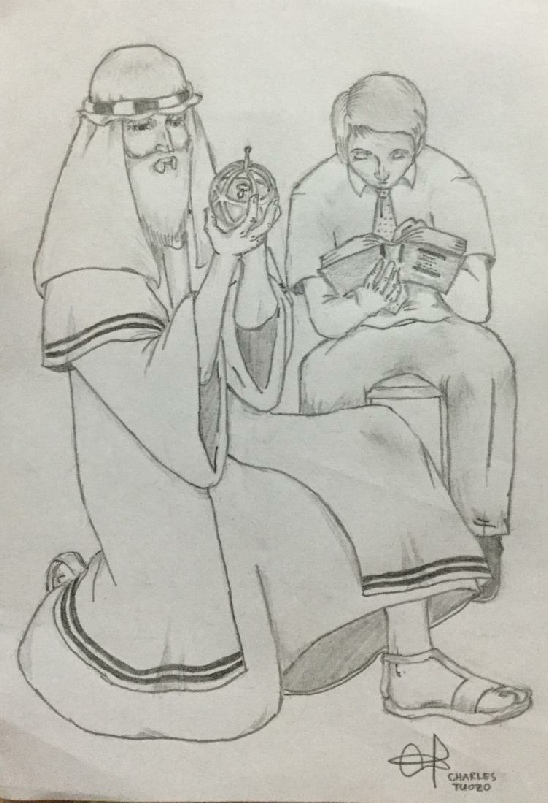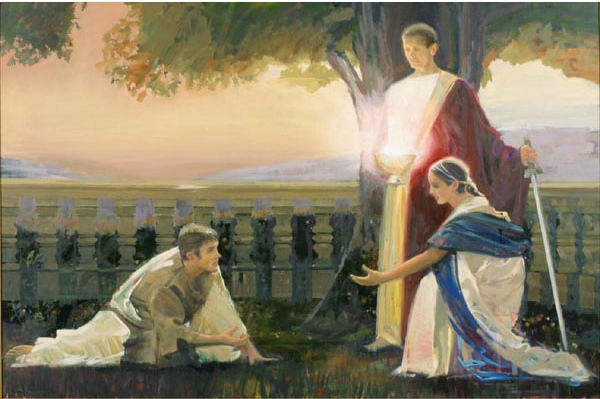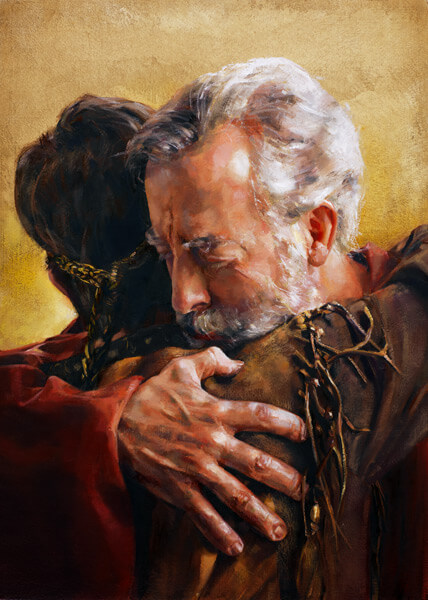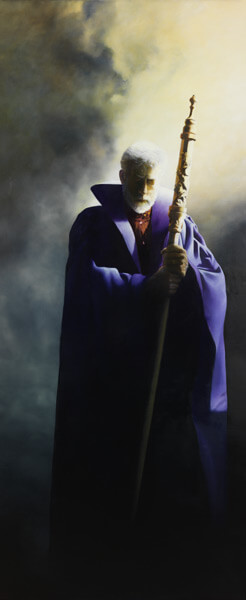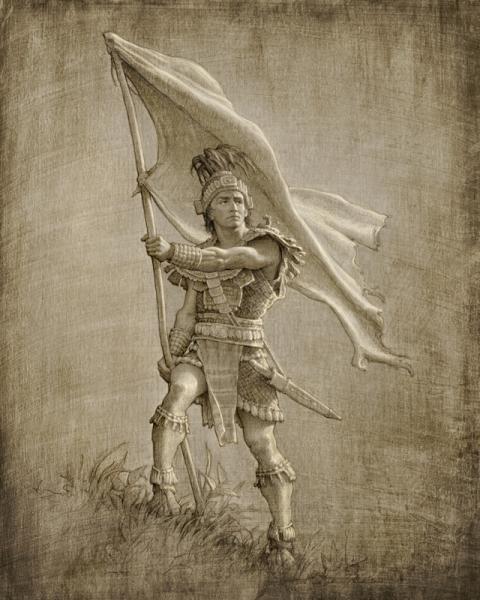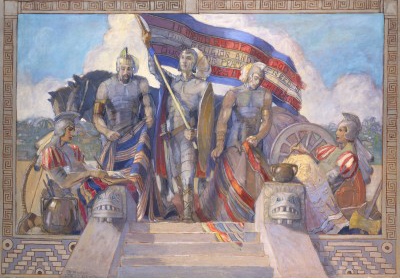






Book of Mormon Feast
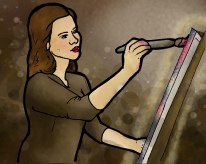
An Artistic Tour of Alma 23-48
Alma 24:12
BOOK OF MORMON MUSIC
“Our Swords Are Made Bright”
Marilyn Arnold & Maurine Ozment
Sacred Hymns of the Book of Mormon, 12
The Lamanites were a wicked and bloodthirsty people, disregarding the value of human life, as they did not know the God who had created them, and who is the Father of all mankind. When Ammon and his brethren converted a group of them, they wanted to forever live in peace. Their king encouraged them to make a covenant with God:
“Now, my best beloved brethren, since God hath taken away our stains, and our swords have become bright, then let us stain our swords no more with the blood of our brethren.”
Our swords are made bright, let us hide them away;
Our swords, let us stain them no more.
Our swords are washed clean through the blood of the Lamb,
Now bury them deep, I implore.
Alma 26
BOOK OF MORMON MUSIC
“In My God I Do Rejoice”
Marilyn Arnold & Maurine Ozment
Sacred Hymns of the Book of Mormon, 13
After their years of trying and successful missionary labors, Ammon spoke enthusiastically about all the Lamanites who had been brought into the fold of God. His brother Aaron rebuked him, saying that he was carried away with boasting.
Ammon replied, “I do not boast in my own strength, nor in my own wisdom; but behold, my joy is full, yea, my heart is brim with joy, and I will rejoice in my God.” He goes on to praise God for all their success.
My heart is brim with joy; in my God I do rejoice.
In His praise I will lift up my voice.
In His praise I lift my voice.
We have reason to praise Him forever.
Alma 29
BOOK OF MORMON MUSIC
“Oh That I Were an Angel”
Marilyn Arnold and Maurine Ozment
Sacred Hymns of the Book of Mormon, 10
Meanwhile, back in Zarahemla, Alma, as leader of the church, was experiencing challenges as his people drifted in their faith and faithfulness. The Book of Mormon records his heartfelt expression of longing to preach repentance to the whole world in such a way that they would have to believe. But he immediately recognized how that plan is not God’s way, and that God has given to each person sufficient information for their time and place.
I’d speak with the trump, with the trump of our God,
With voice that could shake all the earth.
With thunderous voice I would cry to each soul,
Repent, O repent, and hear truth.
Alma 30:44
Book of Mormon Art
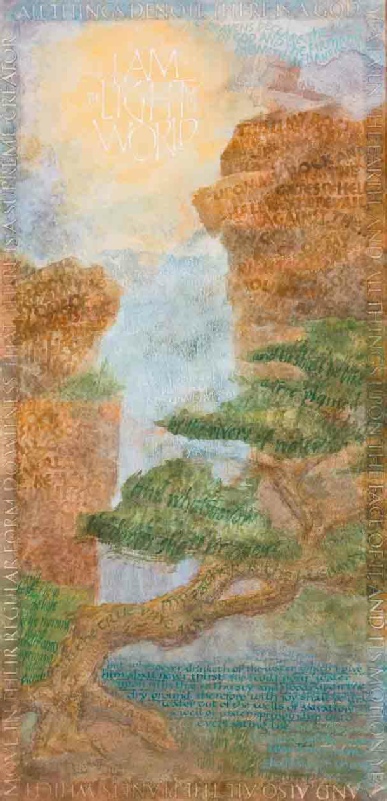
All Things Denote There Is a God
Joan Layton Merrell
Acylic, gouache, colored pencil
Many scriptures use things we see around us every day as symbols of the Savior and His gospel. I included scriptures within the landscape to visually connect the Creator with His wondrous creations, as referred to in Alma 30:44: “All things denote there is a God; yea, even the earth, and all things that are upon the face of it.”
Alma 30:44
Samuel Aubrey Burt
oil on canvas
Alma said that “all things denote there is a God” (Alma 30:44). We believe that receiving revelation is receiving truth that illuminates our understanding. Similarly, the sun rising over the landscape in the morning illuminates our world, revealing the truth around us. This painting reminds me of the hope we have now and the hope we will have because of the greater light yet to come in this last dispensation of time.
Alma 32:26-
BOOK OF MORMON MUSIC
“The Word Is a Seed”
Marilyn Arnold and Maurine Ozment
Sacred Hymns of the Book of Mormon, 27
In one of many beautiful and incisive sermons, Alma taught the people, “Now, we will
compare the word unto a seed. Now, if ye give place, that a seed may be planted
in your heart, behold, if it be a true seed, or a good seed, if ye do not cast it
out by your unbelief, that ye will resist the Spirit of the Lord, behold, it will
begin to swell within your breasts; and when you feel these swelling motions, ye
will begin to say within yourselves -
You’ll know it is good by its growth and its light.
You will feel it enlarging your soul.
Experiment now, test the word by your faith
As you nourish and help it to grow.
Alma 32:28
Kaitlin Acosta
In my painting I wanted to depict the tree of life. When I created it, I thought of Alma 32:28 and it says,"Now, we will compare the word unto a seed. Now, if ye give place, that a seed may be planted in your heart, behold, if it be a true seed, or a good seed, if ye do not cast it out by your unbelief, that ye will resist the Spirit of the Lord, behold, it will begin to swell within your breasts; and when you feel these swelling motions, ye will begin to say within yourselves—It must needs be that this is a good seed, or that the word is good, for it beginneth to enlarge my soul; yea, it beginneth to enlighten my understanding, yea, it beginneth to be delicious to me." I included a heart in the roots to symbolize our testimonies. Like any seed, it needs water, sunlight, and soil. A tree can not thrive on human food. So like a seed of a tree, what we put into our hearts determines what our growth will be. I also included layers of soil to symbolize time. Testimonies aren't always immediate. It takes time, effort, and trust in the Lord. When we do the small and simple things, we will see incredible blessings and grow into our fullest potential.
Alma 32:28
BOOK OF MORMON ART
Kay B. Spjut
We learn in Alma 32:28–43 to “compare the word unto a seed” and nourish that seed with faith so it will grow. This gourd began its journey as a seed that was nourished by faith and loving hands. Now it stands as an object of art, designed to teach the gospel through one of the most powerful symbols in scripture—the tree of life (see 1 Nephi 8).
Alma 32:30
BOOK OF MORMON ART
Natalie Christensen
oil on canvas with clay and shell
“Some of the most wonderful works of God that I have witnessed were the conversions I saw while serving a mission. I witnessed many miracles as I taught the gospel and watched lives change. I made this piece to show the progress of an individual’s conversion. It is more of a process than one large experience, and I wanted to give each stage its own attention. The planting of the seed is just as important as the nurturing of the young plant. As a person matures in the gospel, roots of understanding and commitment reach into the rich soil to provide strength and support for the new life, now visible to others. Conversion happens between individuals and God, but I was blessed to be able to observe the process.”
Alma 32:30
Book of Mormon Art
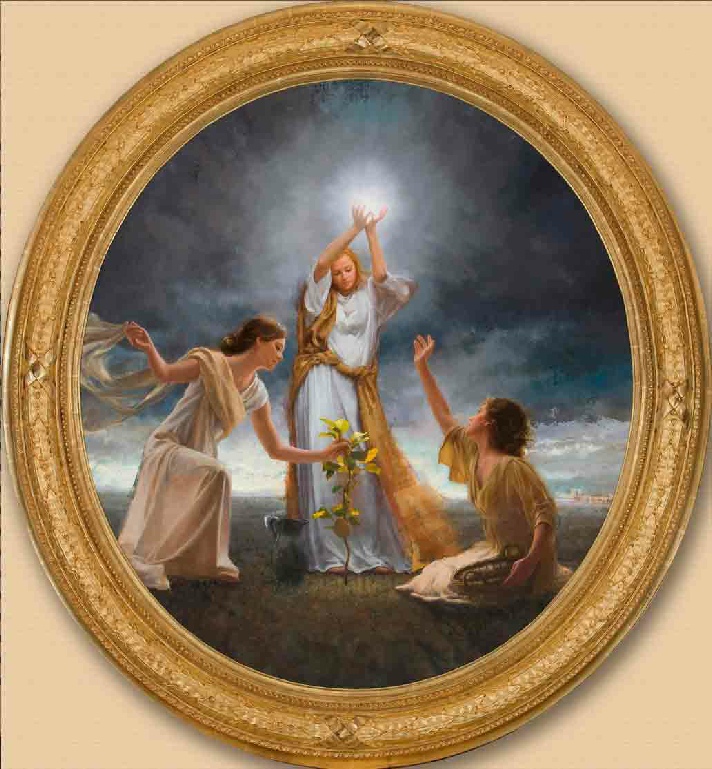
Jonathan Linton
Oil on linen panel
The kneeling figure of Faith calls to the viewer with her right hand as she carefully nurtures a young plant with her left hand. This tender plant is the word of the gospel, as Alma describes (see Alma 32). Hope, the figure on the right, waits patiently but expectantly for the fruit the plant will one day bear as she looks toward Charity. Charity, the pure love of Christ, which “never faileth,” stands in the others’ company, representing the transcendence of charity, as Paul so eloquently describes (see 1 Corinthians 13). Charity holds a light that gives life to the growing plant so that it “swelleth, and sprouteth” and eventually flourishes and bears fruit (Alma 32:30).
Alma 32:41
Marie Withers
In Alma 32, the scriptures describe how we plant the seed of faith, give it care and nourishment, and it will become a great tree. Alma 32:41: "But if ye will nourish the word, yea, nourish the tree as it beginneth to grow, by your faith with great diligence, and with patience, looking forward to the fruit thereof, it shall take root; and behold it shall be a tree springing up unto everlasting life." Normally I paint in oils, but this piece was created in pastels.
Alma 32:43
BOOK OF MORMON ART
Courtney von Savoye
This piece won First Place in the 2018 Book of Mormon Central Art Contest.
This piece was inspired by Alma 32 in the Book of Mormon. In this chapter Alma explains the nature of faith being something believed and not seen. As faith grows it is like a seed being planted in a person's heart and if they are faithful and learn more of the gospel they are blessed with fruit. This is represented in this piece with a girl giving thanks for the fruit that was grown in a barren desert. Since she was faithful she was able to receive her reward and can now grow stronger. The moon and star represents the spirit since her gaze is aimed up toward heaven.
Alma 33:11
BOOK OF MORMON ART
Elspeth Young
“And thou didst hear me because of mine afflictions and my sincerity; and it is because of thy Son that thou has been thus merciful unto me, therefore I will cry unto thee in all mine afflictions, for in thee is my joy; for thou hast turned thy judgments away from me, because of thy Son.”
In the Book of Mormon a group of people (Zoramites) who were not allowed in the houses of worship because of their poverty questioned the missionary Alma as to how they could worship God. He quoted an ancient prophet Zenos in teaching that they could pray anywhere and any time, and God would hear and respond.
Alma 34:17-
BOOK OF MORMON MUSIC
“Cry Unto Him”
Marilyn Arnold and Maurine Ozment
Sacred Hymns of the Book of Mormon, 28
Alma’s missionary companion Amulek answered the poor Zoramites’ question of how to worship God outside of a dedicated building. He very eloquently told them to pray always, in all places, and for all things important to them.
Cry unto him in field and house, and over all that’s dear;
Cry morning, midday, cry at night, and God our plea will hear.
Alma 36
BOOK OF MORMON MUSIC
“I Am Born Now of God”
Marilyn Arnold and Maurine Ozment
Sacred Hymns of the Book of Mormon, 9
The Book of Mormon gives three different accounts of the conversion of Alma the Younger, who later became the chief judge and high priest over the Nephite people in Zarahemla. This chapter is a transcript of his own words to his son Helaman, as he prepared to give him the prophet responsibility and the gold plate records. It is a beautiful and eloquent description of his agony because of sin, and his joy in Christ’s grace and forgiveness. In addition, it is “one of the finest examples of chiastic composition anywhere in world literature.”
I am born now of God, of the Spirit I’m born,
Oh what rapture, what joy, fills my heart!
What light I beheld, and what vision of praise,
And what promise, what hope, it imparts.
Alma 36:12
Robert T. Barrett
Alma 37:23
Anthony Sweat
Recently the Church published the first known photographs of one of Joseph Smith’s
seer stones. Although sources vary, Joseph Smith apparently found a seer stone when
he was 16-
Alma 37:44
Charles Tuozo
Like the Liahona that guided Lehi and his family, The Book of Mormon is our guide to eternal life.
Book of Mormon Art
Alma 42:24
Mercy Claimeth All Which is Her Own
Jonathan Linton
A personification of the role of Christ’s atonement in the relationship between mercy, justice, God, and man. Inspired by the 42nd chapter of the Book of Alma, in the Book of Mormon
Alma 42:30,31
BOOK OF MORMON ART
Elspeth Young
Artist’s Notes:
Alma the Younger was a prophet of God in the Americas during the two centuries immediately
prior to the birth of Jesus Christ. The story of his own waywardness and subsequent
repentance as a youth—resulting in a greatly altered life-
When Corianton was a young man, he accompanied his father, older brother, and several other carefully selected servants of the Lord, who embarked upon a mission to preach the gospel of Jesus Christ to a people who had apostatized from the Church and established their own heathen religion. During his ministry, Corianton abandoned his commission and became entangled in harlotry. His conduct adversely affected the overall success of the effort to reclaim those who had left the Church.
Not long after returning home, Alma, preparing to depart on yet another missionary
journey, gave his farewell blessing to each of his sons. His charge to Corianton
is not only one of the finest doctrinal discourses in all of scripture, but reaches
out to his erring son as an example of undying love fit for the ages. It is the
conclusion of that paternal benediction captured in this painting (see Alma 42:30-
Symbolism in This My Son
While Alma faces the viewer, Corianton is facing away. Consequently, in the expression on Alma's face we see reflected the willingness of God to let us turn our back on the sins we have committed, on the trouble and anguish we have caused, and on the destruction the adversary has prepared for us—the destruction of our happiness, our lives, our very souls. Alma's embrace is neither a partial nor a tentative expression of forgiveness, love, and acceptance, but is powerful in its very grasp; conveying the completeness of the Father's desire to lift us—from where we are—up and out of the darkness seeking always to drag us down. Nor can we see Corianton's face, which means that were we to see him in another context, for example, we would not recognize him, we would not know him for the sinner he had been; we would know him only in the sublime context of God's forgiveness, a truly blessed condition in which He declares that the sins of anyone this forgiven shall be remembered no more.
Corianton's clothing is iconic of the wanderer (any prodigal); unlike the simple purity of Alma's robe, Corianton's garb also draws attention to itself and the wearer. Just as Corianton's boastful behavior drew him "among the borders of the Lamanites, after the harlot Isabel," so his clothing faintly echoes perceptions of traditional Lamanite costume.
Alma 43:16
BOOK OF MORMON ART
Lester Yocum
“Now the leader of the Nephites, or the man who had been appointed to be the chief captain over the Nephites – now the chief captain took the command of all the armies of the Nephites – and his name was Moroni.”
Artist’s notes:
Chosen to lead the Nephite armies at age 25, Captain Moroni became an example of firmness, strength, commitment, and unconquerable faith.
Alma 45:17-
BOOK OF MORMON ART
Elspeth Young
Artist’s notes:
Alma the Younger was born during the second century before Christ and lived into the early part of the first century B.C. He was the first chief judge elected by the Nephites when they altered their form of government to establish rule by judges instead of kings. Alma the Younger was also the presiding high priest over the church among the Nephites who were followers of Jesus Christ.
As ruler of the Nephites, he fought to preserve their form of government when civil war erupted and the dissenters joined forces with the Lamanites. Alma fought with the sword, face to face, with the leader of the rebels and with the Lamanite king. He later resigned his political office to devote full time to what amounted to an extensive itinerant ministry among his own people.
“Alma blessed the church, yea, all those who should stand fast in the faith from that time henceforth.
“And when Alma had done this he departed out of the land of Zarahemla, as if to go into the land of Melek. And it came to pass that he was never heard of more; as to his death or burial we know not of.
“Behold, this we know, that he was a righteous man; and the saying went abroad in the church that he was taken up by the Spirit, or was buried by the hand of the Lord, even as Moses.”
Alma 46:12
BOOK OF MORMON ART
Captain Moroni Raises the Title of Liberty
Arnold Friberg
The Book of Mormon records that, though the Nephites enjoyed freedom under a constitutional republic, one man, Amalickiah, wanted to be king. He was joined by many others who wants to exercise power over others.
The Nephite General Captain Moroni took action to educate his people as to their present privileges, and their obligation to fight for their own freedom:
“And it came to pass that he rent his coat; and he took a piece thereof, and wrote upon it – In memory of our God, our religion and freedom, and our peace, our wives, and our children – and he fastened it upon the end of a pole.”
Artist’s Note:
“In the picture, CAPTAIN MORONI RAISES THE TITLE OF LIBERTY, we see yet another towering
figure, that of Captain Moroni, rallying followers to fight for liberty. When this
picture was being considered, it raised a problem concerning Moroni’s writing on
the Title of Liberty. In the English version of the Book of Mormon, we read that
Moroni wrote upon his torn coat, ‘In memory of our God, our religion, our freedom,
and our peace, our wives, and our children:’ We read it in English, but Moroni didn’t
write it in English. He wrote it in the language of his time, probably a version
of Hebrew. There were those who insisted the lettering be in English. But in a picture
of this historical event the artist wanted the writing to look as close as possible
to how it appeared on the actual flag. The nearest anyone could come to the original
language was to go back to Hebrew as it was at the time when Lehi left Jerusalem.
So I went to my friend Rabbi Cardon and asked him to write out the words of Captain
Moroni as it would have appeared at the time of Lehi and Jeremiah. At that time the
squarish lettering we know today as Hebrew had not yet been invented, so they selected
an earlier writing style, closer in appearance to that of the time of Moses. Of course,
more than 500 years had passed between Lehi’s time and that of Moroni. A language
can change a great deal in that time and we have no way of knowing what such changes
might have been. In the painting, as in the book, there is a factor easily skipped
over but of historical importance. We read that Moroni tore his coat and wrote upon
it. This doesn’t mean that in a burst of passion he ripped the coat to shreds. Rather,
his action bears out a long-
“To rend one’s coat was the most extreme emphatic expression of one’s statement or belief, something akin to swearing with a great oath. Some even carried a small knife to make a modest incision, constituting “tearing.” We recall that at the trial of Christ, the high priest “rent his garment” as evidence that there was no further proof required to sentence Christ before the Jews. To carry this custom even further, the men rallying to Captain Moroni’s call, tore their garments and cast them about Moroni’s feet as a token or covenant of the fervency of their support. Such details are carefully shown in the painting. This last point, that of tearing the cloaks, is a strong evidence of the authenticity of the Book of Mormon. For if, as critics claim, Joseph Smith had written the book just as a novel, it is stretching the imagination to believe he could have known such an obscure bit of Israelite ritual.”
BOOK OF MORMON ART
Joseph Franklin Brickey
Captain Moroni used the Title of Liberty to rally his people to fight against the invaders of their country. The Book of Mormon says that “He went forth among the people, waving the rent part of his garment in the air, that all might see the writing which he had written upon the rent part.”
BOOK OF MORMON ART
Walter Rane
Oil on board, 2003. Commissioned.
Captain Moroni, waving the title of liberty, issued a challenge and an invitation:
“Behold, whosoever will maintain this title upon the land, let them come forth in the strength of the Lord, and enter into a covenant that they will maintain their rights, and their religion, that the Lord God may bless them.”
Alma 46:12,13,19,21
BOOK OF MORMON ART
Moroni and the Title of Liberty
Minerva Teichert
“Holding high his rent garment inscribed with the title of liberty, Moroni is framed
on either side by four soldiers–two are kneeling, writing their oaths on their torn
garments, and two stand at Moroni’s side as they rend their garments in covenant.
Probably painted in 1930, the mural reflects Teichert’s beaux-
Alma 46
BOOK OF MORMON MUSIC
“The Title of Liberty”
Marilyn Arnold and Maurine Ozment
Sacred Hymns of the Book of Mormon, 15
The title of liberty Moroni raised high and called for the brave and the strong
To fight or their freedom to worship in peace, the freedom they cherished so long.
Alma 48
BOOK OF MORMON ART
Steve Nethercott -
At a critical time in the history of the Nephites, the Book of Mormon records that their military commander was Captain Moroni. He was “a strong and a mighty man. He was a man of a perfect understanding, yea, a man that did not delight in bloodshed; a man whose soul did joy in the liberty and the freedom of his country, and his brethren from bondage and slavery.”
